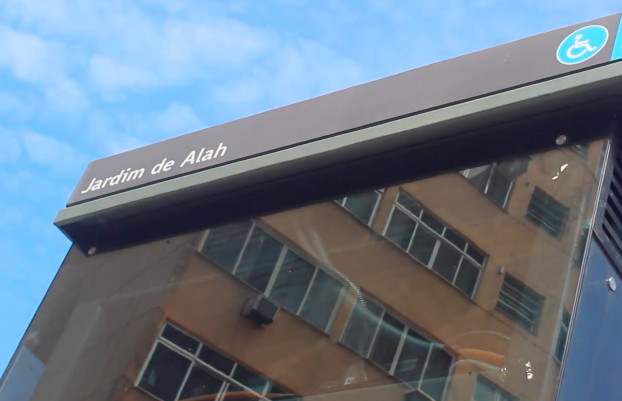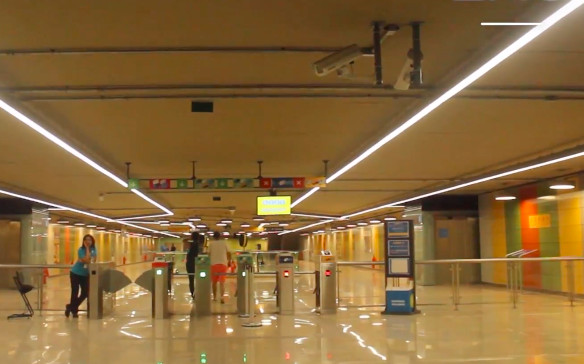The Rio de Janeiro Metro was inaugurated on March 5, 1979. It is the second most used subway system in Brazil, with more than 780,000 passengers per day and 280 million passengers per year. The Metro consists of 41 stations and 2 lines spanning over 57 km long.
Rio de Janeiro Metro
Rio de Janeiro is the most famous city in Brazil. Located in the Southeast region of the country, it attracts many tourists to the beautiful beaches, beautiful scenery and lots of fun (especially Carnival).
The state of Rio de Janeiro is one of the smallest in Brazil and also one of the most populous. It it home to about 8.4% of Brazilian population, becoming the largest state of Brazil regarding population density.
Due to having such a large population and receiving many tourists throughout the year, the city of Rio de Janeiro needed an effective transport system for all.
A little history
The Rio de Janeiro Metro started its operation in March of 1979 with only 4.3 km of track and 5 stations close to the city. Within 10 days after its inauguration, it was used by more than 500 thousand passengers.
Operated by MetrôRio, the system of the Rio de Janeiro Metro had its first expansion in 1980 with the opening of Uruguaiana and Estácio stations, which increased the number of passengers and made it necessary to increase the number of cars in operation.
At the beginning of 1981, the expansion continued and the Carioca, Catete, Morro Azul (now called Flamengo) and Botafogo stations were opened. In the same year the Metro Line 2 was also inaugurated with the Maracanã and São Cristóvão stations, and Line 1 was increased in its section Sul, with the station Largo do Machado.
In 1982, new stations were opened: Afonso Pena Station, Railway Station São Francisco Xavier and Saes Pena. At this time, the operation of trains on this stretch was from 6:00 to 14:00.
 Rio Janeiro Metro station
Rio Janeiro Metro station
The stations that were under construction in this period were completed and inaugurated are: Maria da Graça, Del Castilho, Inhaúma and Irajá. Trains that made the journey from these stations were "Pre-Metro," which did not have all the features of the Metro today.
In 1984, Line 2 began operating with 5 trains on weekdays, with 6 minutes’ frequency. In 1988, the Triagem station began operating and between 1991 and 1996, three more stations were opened: Engenho Rainha Station, Thomaz Coelho and Vicente de Carvalho. From this moment, the lines began to have more and more trains running.
How to Travel by Metro in Rio De Janeiro?
1) Lines
The Rio de Janeiro Metro has 2 lines:
Line 1 - Orange (General Osório - Uruguai).
The stations of Line 1 of Rio de Janeiro metro stations are: General Osório, Cantagalo, Siqueira Campos, Cardeal Arcoverde (Integração para o Leme), Botafogo, Flamengo, Largo do Machado, Catete, Glória, Cinelândia, Carioca, Uruguaiana, Presidente Vargas, Central, Praça Onze, Estácio, Afonso Pena, São Francisco Xavier - Sáenz Peña, Uruguai. Stations under construction: Shopping Rio Sul, Barão de Mesquita, Méier.
Line 2 - Green (Botafogo - Pavuna).
The stations of this line are: Botafogo, Flamengo, Largo do Machado, Catete, Glória, Cinelândia, Carioca, Uruguaiana, Presidente Vargas, Central, Cidade Nova, São Cristóvão, Triagem, Maria da Graça, Nova América - Del Castilho, Inhaúma, Engenho da Rainha, Thomaz Coelho, Vicente de Carvalho, Irajá, Colégio , Coelho Neto, Acari - Fazenda Botafogo, Eng. Rubens Paiva, Pavuna. IMPORTANT: On weekends, line 2 runs only to the Estacio station.
Line 4 - Yellow
Open since September 2016. This new line was opened during the 2016 Olympics only for people who had tickets for the games. In September it will be open to the public.
Stations: Jardim Oceânico, São Conrado, Gávea, Antero de Quental, Jardim de Alah, Nossa Senhora da Paz
2) Connection
The Orange and Green lines intersect at the following stations: Central, Presidente Vargas, Uruguaiana, Carioca, Cinelândia, Glória, Catete, Largo do Machado, Flamengo, Botafogo.
It is possible to transfer to the train service in Rio de Janeiro called SuperVia. It can be made at the following stations of Line 2: Central, São Cristóvão, Maracanã, Triagem, Pavuna.
3) Airport Connection
There are two airports in Rio de Janeiro Galeao Airport and Santos Dumont Airport. To get to Galeao, you need to access the subway line 2 to the Vicente de Carvalho station. At this station, take one of the bus lines BRT (Rapid Transport Ônibus): Transcarioca Line with stops, or the Transcarioca Expressa Line.
It is also possible to reach Santos Dumont Airport by metro. For both, go to Cinelândia station and take the VLT (Veículo Leve Sobre Trilhos) to the airport (the ride is 7 minutes). IMPORTANT: The VTL must be paid with a prepaid card Bilhete Unique Carioca. You can purchase this card at Santos Dumont Airport and the also in other outlets RioCard, and in vending machine. The machines accept cash, but do not give change.
4) Languages in the Rio de Janeiro Metro
Announcements made in the Metro system are in Portuguese and English.
5) Schedule and frequency
The Rio de Janeiro Metro runs daily. Hours are Monday through Saturday from 5:00 to 00:00, Sunday and holidays from 7:00 to 23:00.
The frequency is 4-7 minutes on Line 1 and 5-10 minutes on line 2.
 Rio Janeiro Metro schedule
Rio Janeiro Metro schedule
6) Rates of Rio de Janeiro subway.
Common rate for Users: R $ 4.10
Common tariff metro + bus: R $ 4.10
-
The following people travel for free:
- Students from public schools in Rio de Janeiro
- Persons over 65 years
- People with disabilities and also with a companion authorized
- People with chronic illness
- Children up to 6 years old (accompanied by a responsible adult)
7) Cards
MetrôRio Prepaid Card
It can be purchased in subway stations or in a vending machine. It is very useful for those who are traveling and want to use the metro system of Rio de Janeiro to see the city. It can be used on the bus and subway without being in queues. It also offers discounts for theatres. Minimum load: R $ 5.00.
Tarjeta Unitário (Unitary Card)
The Unitary single card is used only for metro rides and does not provide any additional benefit. If you purchase and do not the use credit, you can request a refund of the amount in one of the subway stations. IMPORTANT: this is the only card that can be used to pay for integration with other public transport services in Rio de Janeiro, such as Supervia and Intermunicipal Integration.
Metrô na Superfície" Card
This card can be used in the extension of bus lines, the "Metro na Superfície" service, which completes the system of Rio de Janeiro Metro.
8) Payment Methods
Cards can be purchased at any station in Rio de Janeiro subway, and payment is cash only.
9) Special Information
- The first subway car is pink because its use is exclusively for women and children during peak hours.
- Bikes are permitted on the metro during the week after 21:00 and on weekends. You must take the last car.
- Surfboards are permitted on weekends and holidays, only if they are covered and measure less than 2 meters.
- There are lifts and ramps in some of the stations in the Rio de Janeiro Metro, among other accessibility options: Vertical Platform Flat Touch, information in Braille, and others. You can see all subway accessibility options here
10) Special services at stations
There are some special services at all stations Metro System of Rio de Janeiro:
- Free wifi access in all subway stations
- Network of Stores in different sectors in metro stations
- Vending Machines to purchase or recharge cards in all seasons
- 24-Hour Electronic Boxes for quick banking transactions (this service is not available in all seasons).
- Public Restrooms at the following stations: Acari Fazenda Botafogo, Botafogo, Cantagalo, Carioca, Cidade Nova, Coelho Neto, Del Castilho, Estacio, General Osório, Pavuna and Siqueira Campos.
 Rio Janeiro Metro
Rio Janeiro Metro
What interesting places can I visit in Rio de Janeiro from the Metro?
- Cristo Redentor (Christ the Redeemer): is one of the 7 wonders of the world, and the main image of Rio de Janeiro. Directions: From the Largo do Machado Station, you can take the bus that makes the trip to Cosme Velho, and arrive in front of the São Judas Tadeu church. From this stop you can take the Corcovado train to reach Christ the Redeemer. It's a nice ride!
- Pão de Açúcar (Sugar Loaf Mountain): Another almost mandatory ride in Rio is up to Sugar Loaf Mountain in the Travia, a large cable car that offers an amazing view of the city. Directions: From the Botafogo Station, you can take bus 513 – Botafogo Urca, which goes to the Pão de Açúcar.
- Sambódromo (Sambadrome): Especially during Carnival, Sambadrome is a site of celebration and magic for tourists and inhabitants of Rio de Janeiro. Every year the festival attracts thousands of people. Directions: From the Praça Onze Station, walk towards Avenida Marques de Sapucai.
- Ipanema Beach: One of the most popular beaches of Rio de Janeiro, inspiration for the famous song "Girl from Ipanema" by Tom Jobim, also sung by Frank Sinatra. Directions: From the General Osório Station, walk towards Vieira Souto Avenue.
- Copacabana Beach: Another very nice and well-known beach in Rio de Janeiro, this beach attracts tourists and cariocas (another name for the inhabitants of Rio de Janeiro). Directions: The beach is near the metro stations Cardeal Arcoverde, Siqueira Campos and Cantagalo. From any one of these it is possible to arrive to Copacabana.
Media
Metro map of Rio de Janeiro
See map full resolution. It may take a little bit to load.Download map.
Some other metro maps of Rio de Janeiro
Rio de Janeiro metro map
- Also Known As:
- Passengers/Day 780000
- Fares: R$ 4,10
- 24h operation: No
- Air Conditioning: Yes
- Walk between platforms: No
- Driverless trains: No
- Screen Doors Platforms: No
- Operator: Rio Trilhos
- R$ 4
- Rio de Janeiro Metro Official Website
Help us
If you consider that the information we provide is wrong, not accurated, outdated, translation contains errors, and you would like to help us to improve the file...you can contact us here.
Feel free to contact us if you dont find the system you're looking for and we'll add it as soon as we can!
Thank you very much!







